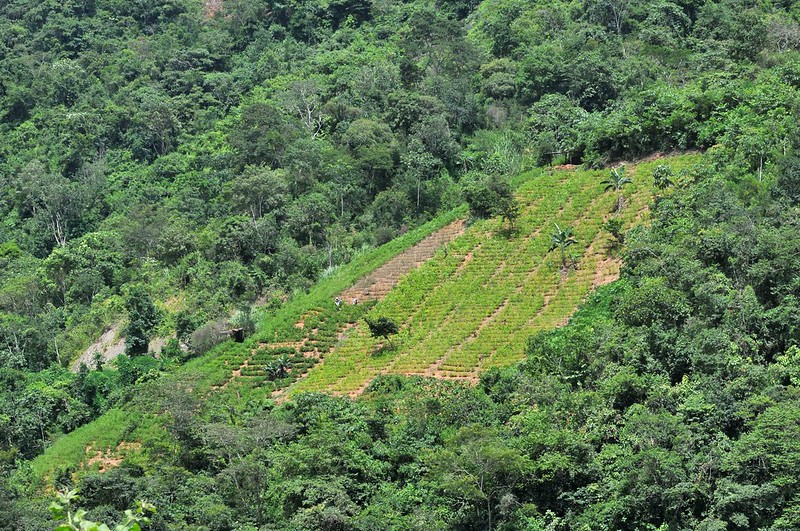
At the beginning of February of this year, as part of Operation Hunter under the supervision of a judge with national jurisdiction, agents of the National Anti-Drug Police Directorate (DNPA) and the Honduran Special Operations Command (COE) seized a coca plantation.The operation, which took place in a rural area within the department of Colon, gathered more than 13,000 plants and elements necessary for the manufacturing of cocaine paste. Central America joins cocaine production?
The idea that Central America is exclusively a transit region for drugs from South America to consumer markets in the north is beginning to be questioned. Although it continues to be a zone of reception and dispatch of shipments from the south, the fact is that, for some years now, countries such as Guatemala and Honduras have also been becoming, albeit slowly, producers of this drug.
The emergence of crops
Central America is one of the most violent regions in the world, but as if that were not enough, since the middle of the last decade security forces have been discovering coca crops in isolated and sparsely populated areas in those two aforementioned countries. And there are those who claim that there are probably experimental crops in El Salvador and Nicaragua as well, yet to be discovered.
The countries of the Northern Triangle – El Salvador, Guatemala and Honduras – have been absorbing much of the drug trafficking from the south for decades. Vast, isolated, almost inaccessible regions, such as most of the Honduran Mosquitia, contribute to this phenomenon. They also have extensive maritime coasts and naval forces that do not always have the operational capacity to adequately control them.
In 2018 it was said: “for now, illegal crops in the Northern Triangle are more anecdotal than dangerous. Some 50 hectares in Honduras are nothing…”. However, more extensive crops have been discovered, with laboratories, greenhouses and technology to produce larger quantities of cocaine, in better conditions and with higher quality. This is a cause for concern, although production has not yet reached significant figures.
Central American plantations
In May 2018, due to a “tip-off,” Guatemalan security forces entered almost inaccessible areas of Alta Verapaz, a region with hills up to 2,500 meters high, hot and humid. It is a territory very similar to the Andes of the Amazon basin, where the best coca crops are grown. It was an operation carried out under strict reserve, which led to the discovery of the first coca leaf crop in the country.
That same year, Honduran authorities discovered three plantations, one of them of about 20 hectares. These discoveries began to show that the cartels are looking for production alternatives closer to the world’s largest consumer market: the United States. The shorter distance of Honduras and Guatemala from the United States, compared to Peru, Bolivia or Colombia, significantly reduces transportation risks and the costly and complex logistics required to transport tons of basic paste from South America.
Crop growth in Honduras
Since 2017, coca leaf plantations have been found in Honduras in the departments of Yoro, Olancho and Colón, all located in the northern part of the country. The first cultivation was found in April 2017, in a mountainous area of Esquipulas del Norte, in Olancho. Some 84,000 square meters of plantations and an annexed narco-laboratory, whose activities dated back some time, were found. In 2019, authorities found several blocks of coca leaf in the department of Colon, bordering the Caribbean coast. This department is where most hectares of plantations have been found.
Despite the increase in the number of plantations seized in the country, some analysts believe that these crops have virtually insurmountable limitations. One of them is that the Honduran territory is small and that coca leaf requires a lot of land clearing to receive sufficient sunlight, which would make the plantations easily visible from the air. However, according to police authorities, if these plantations were interspersed and smaller in size, they would not be so easy to spot and could even be mistaken for cattle ranching.
Although the conditions in Central America are not the most ideal, the growing trend of this phenomenon is worrisome considering the context of the Northern Triangle: countries with weak institutions, high levels of corruption, armed and security forces permeable to the “incentives” of drug trafficking and societies immersed in violence, produced by both common and organized crime. In addition, all three societies are suffering the effects of persistent economic crises, now structural, which have led to massive migration and displacement. All these ingredients are fertile ground for coca crops to become a survival alternative for marginalized families living among hills, jungles and forests, where authorities have little or no presence.
*Translation from Spanish by Emmanuel Guerisoli


